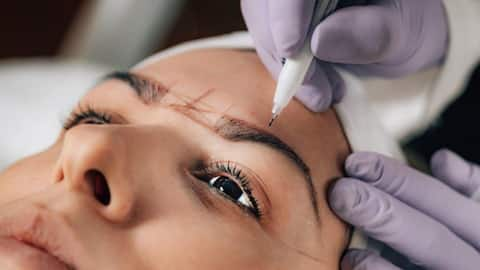Permanent makeup: Here's what you need to know
What's the story
Permanent makeup or cosmetic tattooing is a trend that is quickly gaining popularity in the world of beauty.
This long-lasting cosmetic technique enhances facial features by applying pigment beneath the skin using a tiny needle.
This trend has become increasingly popular as it allows people to maintain a glamorous appearance throughout the day.
Popular treatments include eyebrow microblading, permanent eyeliner, and lip blushing.
Benefits
Benefits and popularity of permanent makeup
Permanent makeup offers a time-saving and cost-effective solution for individuals who regularly purchase and apply high-end makeup products, as the results can last up to two years.
The main advantage of permanent makeup is the convenience of always having flawless makeup without the daily effort of applying it, making it perfect for those with busy lifestyles or little interest in makeup application.
Treatments
Different treatments
Some common permanent makeup treatments include lip tint, cheek tint, microblading, permanent eyeliner, and faux freckles.
Microblading creates natural-looking eyebrows with hair-like strokes that can last up to two years with proper aftercare. Permanent eyeliner adds definition to the eyes, while lip blushing provides a subtle color tint to the lips.
Meanwhile, faux freckles involve tattooing small, natural-looking freckles onto the skin.
Differences
Tattooing v/s permanent makeup
Since both permanent makeup and tattoos entail applying ink to the skin, they are often confused with one another.
There are clear distinctions between the two. While the more surface pigments used in permanent makeup often fade after two years, the pigment used in tattoos is considerably deeper and lasts a lifetime.
Permanent makeup is essentially a semi-permanent cosmetic solution.
Risks
Risks involved
Infections are a significant concern since the needle penetrates the skin's outer layer, leaving it susceptible to bacteria and viruses.
Other potential side effects include scarring, allergic reactions, and pigment migration. Consulting a dermatologist before undergoing any permanent makeup procedure is essential.
To prevent infections and complications, it is also essential to follow aftercare guidelines.
Keep the treated area clean, dry, and moisturized as directed; avoid sun exposure, strenuous activities, and makeup products in the treated area until fully healed.
Bottomline
Things to note
When choosing a permanent makeup artist or studio, consider factors such as certification, experience, reviews, and cleanliness.
Inquire about their pigment usage, sterile environment maintenance, aftercare instructions, and procedure duration.
Ask your artist to walk you through any worries or hesitations you may have regarding side effects, and make sure you take all the required safety measures to help reduce the associated risks.
